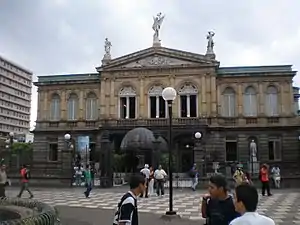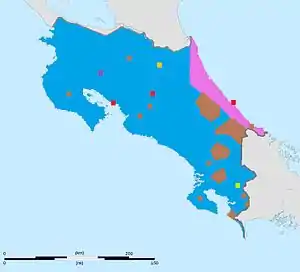Italian Costa Ricans
Italian Costa Ricans are citizens of Costa Rica who are of Italian ancestry. Most of them reside in San Vito, the capital city of the Coto Brus Canton.
| Total population | |
|---|---|
| 2,300 Italian citizens[1] +500,000 -1,000,000 descendants (about 20% of Costa Rica's population)[2] | |
| Regions with significant populations | |
| Coto Brus Canton · San José | |
| Languages | |
| Costa Rican Spanish · Italian | |
| Religion | |
| Roman Catholicism |
Migration history
After Cristoforo Colombo's discovery of Costa Rica in 1502, only a few Italians - initially mostly from the Republic of Genova - moved to live in the Costa Rica region. The italo-costarican historian Rita Bariatti named Girolamo Benzomi, Stefano Corti, Antonio Chapui, Jose Lombardo,[3] Francesco Granado, and Benito Valerino between those who created important families in colonial Costa Rica.[4] In the 1883 census of Costa Rica there were only 63 Italian citizens and most of them living in the San José area, but soon in 1888 there were 1433 Italians working mainly in the creation of new railways.
In 1888, the railroad brought in laborers from Italy as an alternative workforce.[5] The terrible work conditions prompted them to leave the railroad project although many remained in Costa Rica, settling in a government-sponsored colony known as San Vito in the Southern Pacific region.

However, one third of those Italian workers of the railways remained in Costa Rica: they created a small but important community.[6]
In the 1920s and 1930s the Italian community grew in importance, even because some Italo-costaricans reached top levels in the political arena: Julio Acosta García - descendant from a Genoese family in San Jose since colonial times - served as President of Costa Rica from 1920 to 1924. In 1939 there were nearly 15000 Italians resident in Costa Rica and many suffered persecutions during WW2[7]
In 1952, there was an influx of Italian immigrants, mainly farmers, who arrived in San Vito armed with tractors and other farm machinery, and began to farm the land intensively and to raise cattle. An Italian organization for agricultural colonization purchased 10,000 hectares of land from the government of Costa Rica.[8]
Indeed in the 1950s a group of 500 Italian colonists settled in the area of San Vito (that received this name as an homage to San Vito, an Italian saint).[9]
In 1952, in the midst of the post-war socio-economic crisis in Europe, the two brothers Ugo and Vito Sansonetti organised a group of Italian pioneers from forty different places, from Trieste to Taranto, and including a handful from Istria and Dalmatia.
This Italian immigration is a typical example of directed agricultural colonisation, similar in many ways to the process in other places in Latin America. The European immigrants were helped by the Comité Intergubernamental para las Migraciones Europeas (CIME), (Intergovernmental Committee for European Migration).
Vito Sansonetti, a seaman by profession, was the founder of the colonising company which he named Sociedad Italiana de Colonización Agricola (SICA), (Italian Agricultural Colonisation Society), and was in charge of negotiations with the Costa Rican authorities represented by the Instituto de Tierras y Colonización (ITCO) (Institute of Land and Colonisation).
Actually San Vito is the only place in Costa Rica (other than some small communities) in which the teaching of the Italian language is compulsory in the educational system, and promoted by the Ministerio de Educación Pública (Ministry of Public Education) in order to save Italian customs and traditions. Additionally there it is an Italian cultural center in San Vito as well as several Italian restaurants. But the Italian language is usually spoken only by the older citizens of San Vito, even if many young people have some superficial knowledge.
Culture
There are many institutions and cultural associations in Costa Rica. The historical nucleus of the Italian community in Costa Rica was the city of San José: this community is the one that has received more Italian immigrants in all Central America. Nowadays, the capital still has this centralization role for the local Italians, since it shelters the majority of the Italian citizens (and their descendants) residing in the country, although there are now other centers that concentrate considerable numbers of immigrants (like San Vito).

In 1890, the Italian Philanthropic Society ("Società Filantropica Italiana") was created, just two years after the first mass immigration from Lombardy and northern Italy. Then, it would evolve in several Italian Organizations of Mutual Aid until 1902, when it was beginning the massive immigration from southern Italy and was created the Italian Society of Mutual Help ("Società Italiana di Mutuo Soccorso").
In addition, in the capital was inaugurated the "Italian Club" in 1904, the "Italian Center" in 1905 and later the "Casa d'Italia" in the second half of the 20th century. In 1897 Italian engineer Cristoforo Molinari created the Teatro Nacional de Costa Rica, that is considered the finest historic building in the capital, and it is known for its exquisite interior which includes lavish Italian furnishings.[10]
On the other hand, many Italian cultural and educational institutions were established in the country; among them many schools while the principal of all is the "Dante Alighieri Institute of Costa Rica", established in 1932, which currently has four venues (two in San Jose, one in Heredia and another in Quesada,.[11] Also, the "Bologna Institute" and the "Italy-Costa Rica Cultural Center" are important in the capital.
Furthermore, in the small city of San Vito, where 3000 of the 5000 inhabitants are descendants of Italian colonists, the "Centro Cultural Dante Alighieri" (Dante Alighieri Cultural Centre) offers historical information on the Italian immigration. There is an Italian "meeting" center in San Vito's Catholic church, as well as several Italian restaurants.
In San Vito there is the Liceo Bilingüe Ítalo-Costarricense, where it is taught the Italian language as an official compulsory subject.[12] The Italian language is usually spoken by some of the older citizens of San Vito who moved from Italy in the 1950s.
Italian language in Costa Rica
Costa Rica is the Central American country with the largest and flourishing Italian-speaking community. Apart from San Jose, the area with the greatest presence of speakers is the Southern Zone, especially in the cantons of Coto Brus and Corredores, where there are communities like San Vito that were colonized by Italian immigrants and where the language is still spoken actively, with a majority of Sardinian, Calabrian and Sicilian varieties. Furthermore, in these communities of Coto Brus,[13] the Italian language is taught in regional public education, and throughout the country there are many schools that also teach the language as an optional subject.[14]

Also noteworthy is the lasting southern influence in certain phonetic and lexical aspects of Costa Rican Spanish. Among the Italian linguistic inheritances, the best known is the pronunciation of the r and rr, which the majority of the population pronounces as a deaf alveolar rhithic fricative, as do the Sicilians. On the other hand, it exists in modern Costa Rican "slang" a multitude of Italianisms: acois (from the echo: here), birra (from the beer: beer), bochinche (fight, disorder), capo (someone outstanding), bell (from it: bell jergal: spy, means to watch), canear (from the "canne: police baton, means to be in jail"), "chao" (from the "ciao: goodbye"), facha (from "faccia": "face, used when someone is badly dressed"), used when someone is poorly arranged) and sound (from the suonare: sound, means to fail or hit), among many others.
Notable people
- Julio Acosta García - Costa Rican President (1920–1924)
- Jorge Rossi Chavarria - Costa Rican politician
- Carlos Gagini - Costa Rican intellectual, philologist writer and linguist
- Bruno Stagno Ugarte - Costa Rican Minister of Foreign Affairs and ambassador
- Lola Castegnaro - Costa Rican conductor, composer and music educator
- Erick Cabalceta - Costa Rican footballer
- Anacristina Rossi - Costa Rican writer
References
- Inec — Sección de Estadística Archived 2012-03-27 at the Wayback Machine. INEC.
- http://www.uned.ac.cr/acontecer/a-diario/gestion-universitaria/1457-costa-rica-e-italia-paises-unidos-por-la-historia-y-la-cultura
- Carmela Velazquez: Chapui-Corti-Lombardo
- Rita Bariatti: La immigacion esporadica durante la epoca colonial (La inmigracion italiana en Costa Rica, segunda parte)
- "Costa Rica's Culture & People - The Italians". itravel-costarica.com. Archived from the original on 17 February 2010.
- Rita Bariatti: El flujo migratorio masivo (La inmigracion italiana en Costa Rica, cuarta parte)
- Italians in Costa Rica internment camps
- "San Vito, Costa Rica Vacations". travelwizard.com. Archived from the original on 21 November 2008.
- Italians of San Vito (in Italian)
- Baker, C.P. (2005). Costa Rica. Dorling Kindersley Eye Witness Travel Guides. p. 60.
- History: Dante Alighieri Society "Our-history". Editor Dante Alighieri Cultural Association in Costa Rica (http://www.dantecostarica.org)
- Colegio Italo-Costarricense
- Sansonetti V. (1995) Quemé mis naves en esta montaña: La colonización de la altiplanicie de Coto Brus y la fundación de San Vito de Java. Jiménez y Tanzi. San José, Costa Rica
- San Vito, un pueblo de Italianos emigrados (in Spanish)
Bibliography
- Bariatti, Rita. La inmigración italiana en Costa Rica. Revista Acta Académica. Universidad de Centro América. San José, 1997 ISSN 1017-7507
- Cappelli, Vittorio. "Nelle altre Americhe", in Storia dell'emigrazione italiana. Arrivi, a cura di P. Bevilacqua, A. De Clementi, E. Franzina. Donzelli. Roma, 2002.
- Cappelli, Vittorio. Nelle altre Americhe. Calabresi in Colombia, Panamà, Costa Rica e Guatemala. La Mongolfiera. Doria di Cassano Jonio, 2004.
- Liano, Dante. Dizionario biografico degli Italiani in Centroamerica. Editore Vita e Pensiero. Milano, 2003 ISBN 8834309790 ()